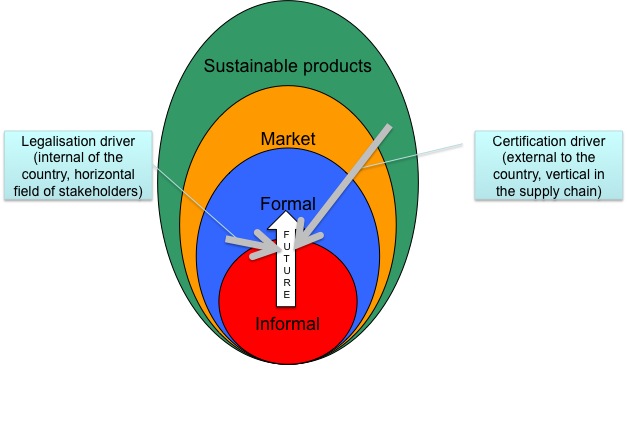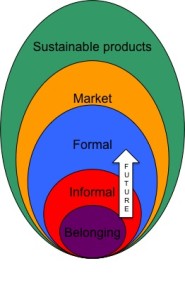Sustainable supply chains and certification
In the debate and work on sustainable development, a lot of effort is put in making the production and distribution of products more sustainable, generally described as sustainable supply chains. I probably do no need to point out that there are many negative social and environmental impacts in the current mainstream production.
The aim of sustainable supply chain is achieve sustainability impact through markets. It aims to make sure that commodities are produced under certain environmental and social minimum criteria, or better still, that they create social and environmental value next to economic value.
Many supply chains make use of certification schemes or standards. Producers comply with certain criteria. This is assured through working according to certain procedures and are checked by independent organizations. Products made under these criteria can then be sold as sustainable products, leading to consumer preference and the willingness of the consumer to pay more. Well known standards are Fair trade, Organic, the Forest stewardship Council (FSC) for wood products and Marine Stewardship Council (MSC) for fish.
New way of looking at the function of certification
In recent work I did on responsible small scale mining of gold, I gained some insights on the role that certification plays and the function it has in the countries and communities where products are being mined (or harvested). In this blog, I would like to share that insight. It is my hope that it will give people working in this field a new way of looking at what they are doing and hope it will support them in making even better decisions.
I will use Spiral Dynamics Integral model for this. I have been trained in Spiral Dynamics and in my projects use it as a lense to understand the complex reality we live in.
Spiral Dynamics is a sociological, psychological developmental model of values and value systems, which can be observed in people, communities, organizations and countries. For this blog I assume basic knowledge of the model, if you do not have that, please read the text at the end of this blog. More information on Spiral Dynamics can be found on spiraldynamics.net.
Small scale gold mining
Currently, a significant part of gold is being mined by small scale miners. People on their own are mining ore under bad social and labor conditions. The way of mining also has large negative environmental impacts mainly through the use of toxic chemicals. Organisations such as Solidaridad and ARM are working with these miners to comply for example with a Fairmined standard, and through that improve their livelihoods.
Development from RED to BLUE
I will argue that certification supports miners organisations to develop from a Spiral Dynamics RED system to a Spiral Dynamics BLUE system.
In my work I found that the certification leads to better improved working conditions, such as higher salaries, better and safer working conditions. Also, for example because of a more stable income miners were able to pay for a higher education for their children.
These impacts on miners and miners organizations were mainly a result of the formalization of their organizations, which can be seen as the development of the Spiral Dynamics BLUE system. When miners do their work ‘informally’, ie within a Spiral Dynamics RED system, the risks involved are high: the working conditions are unsafe and there always is a threat of conflicts with other miners (e.g. “stronger” miners will take over your shaft, if they find out that you have hit a vein). Informal miners live their lives on a day-to-day basis, with no investments in the future. This strongly limits the prospects of miners. And informal miners depend on the benevolence of the middle man, which often results in low prices for their products. On the other hand they have to buy their chemical inputs on informal markets, where the prices are higher. These are all characteristics of being part of a Spiral Dynamics RED-system.
If the miners commence the process to formalization and organization the works becomes safer, the working conditions improve – including higher and more stable salaries and health and income assurance – and they gain a perspective on their future. They actually start to HAVE a future. This is a key characteristic of the BLUE system, ie the ability and willingness to postpone immediate satisfaction of needs (RED system) for something higher, something better in the future (in religious BLUE systems, this is the heaven after death). In more mundane terms, money is not being spent immediately, but saved and used to invest in better technologies, leading to higher productivity.
Furthermore, through a legal status independent exporting to international markets becomes possible (access to the ORANGE market system). Also a connection to a Spiral Dynamics ORANGE system market is only functional if there is enough BLUE in the supplying organization. The ORANGE system needs security of supply and that the supplying organization is able to work according to certain procedures and systems. Much more can be said about what happens when there is not enough BLUE. The opportunistic side of the ORANGE-system will still work with the supplying organization, but there are higher risks of power misbalances, agreements not being met and illegal (or informal practices as RED would call it) such as facilitating payments or corruption. Maybe for another blog….
Formal organizations can thus enter the international market. In these markets, mainly US and Western Europe businesses are encouraged by governments, consumers and civil society to produce their products under good social and environmental conditions. These demands come from the Spiral Dynamics GREEN- system in these consumers and citizens.
The driver for development of formalized BLUE systems of certification is external and comes from the international market, and is based on connections in the supply chain – a “vertical” connection. Next to certification, there are also another driver for formalization, the governmental regulations of a country. These regulations define rules for a sector, and can be considered “horizontal”. The process of formalization understood from a Spiral Dynamics perspective and the two drivers are represented in the figure below.
Figure. Two drivers for the move from informal to formal
RED to BLUE, so what?
So, say that you follow my case that the basic function of certification is to support the development of BLUE systems. And that BLUE systems are much needed for developing a future, a better future with more wellbeing for the communities and countries involved and the connection to the ORANGE markets.
You could say, nice insight, but now what? What can we do with that? How can it inform our decisions and interventions?
I see two ways, but probably there are more.
Align certification and legislation efforts
One, first it is important to see that both regulation and certification supports the same development, from RED to BLUE. It should be avoided that certification efforts undermine the capacity of government to develop and enforce legislation. Some governments experience certification as Western external forces trying to determine a countries policy making. Preferably certification should support the development of good legislation, as happened in the tea sector in India. Also, vice versa legislation should support and not undermine the efforts of certification.
Importance to strengthen community cohesiveness
Secondly, more concretely, Spiral Dynamics suggests that the development from informal to formal, the development from the Spiral Dynamics RED-system to the Spiral Dynamics BLUE system is easier to make if there is a strong, underlying sense of belonging in the communities and when general circumstances are safe. In Spiral Dynamics terms, that is a strong and healthy PURPLE system. For the Spiral wizards under us, PURPLE develops into BLUE through RED. The safer the environment, the stronger the family bonds and the higher the sense of belonging, the more cohesive the community, the easier it is to make the step from informal to formal. The need for a sense of belonging and healthy PURPLE is represented in the figure below.
Figure. Importance of sense of belonging for development from informal to formal
Next to training and supporting miners organisations to become more organized and comply with procedures, organisations working with miners should direct interventions to community cohesiveness. I see two ways. They could use community cohesiveness, or strong PURPLE, as a selection criteria for which communities to work with, to ensure higher success rate and better returns on their efforts.
Secondly, these organizations could also develop the skills and/or partner with organizations that have the skills to increase the sense of belonging and cohesiveness in communities, for example by strengthening existing celebrations, rituals and festivities. Women usually play a crucial role in healthy PURPLE. They will find that their efforts to formalize and certify are much more effective once there is a healthy PURPLE system.
Ard Hordijk, August 2014
[1]Many certification schemes arose, because of lack of government legislation or lack of government’ ability to enforce existing regulations. Depending on the specific country the relative strength of these drivers is different. For example in Peru, miners have separate strict requirements to fulfill. In other countries, such as Colombia, the internal driver of governmental regulation is largely absent. Many governments prefer to only have large-scale mining companies, as they are expected to generate more (tax) revenues and are considered to be “less of a hassle”. In countries where governments have decided not to acknowledge ASM mining (and hence not develop regulation for them), miners are excluded from the process of formalization. They are driven from being informal to being illegal.
ANNEX Short description of Spiral Dynamics
Spiral Dynamics (Beck, 2006) describes value systems in humans as adaptive intelligences that arise as responses to specific external circumstances or specific problems. If these issues are addressed, energy is released. At the same time new problems arise from the new solutions with a higher complexity, asking again for new answers.
Some of the basic principles of Spiral Dynamics are:
- People and organizations have different value systems at their disposal simultaneously;
- New value systems evolve to greater complexity. They transcend and embrace all the older value systems, the so-called principle of “transcend and include”;
- If the circumstances require so, older systems will become active in people;
- One value system is never better than the other, only a more appropriate response to a particular situation;
- People in the same circumstances can and will develop different value systems;
- People can find the same subjects relevant from different value systems (eg ‘traditionalists’ find environmentally friendly behavior is important because they want to be careful with what they have, “postmodernists” because they are in touch with nature and the environment);
- Within Spiral Dynamics the main way of working is trying to understand and reflect on the dynamics of the current value systems in people and organizations, and intervene from that insight.
Until now, Spiral Dynamics describes eight value systems. The writers Beck and Cowan have given a color for ease of communicating all levels:
- Beige – necessities, roof over head, survive
- Purple – security, pride, identification, tribal, magic, rituals, passage rites and traditions
- Red – impulsive and self-centered, energy, power, survival of the fittest, respect
- Blue – Aim / authority, truth, traditional, according to the rules, as it should be, sacrificing yourself for the greater good
- Orange – strategic, individual expression, success, modern, universal human rights, rational, progressive thinking, management
- Green – postmodern, community, equality, feelings, sensitivity, fair distribution of the world’s resources, consultation and consensus
- Yellow – integral, synergy, flexibility, spontaneity and functionality, system of systems
- Turquoise – holistic, experience the wholeness of existence, intuitive way of thinking


Great analysis, Ard!!!!